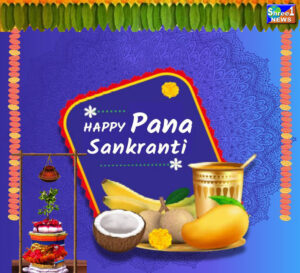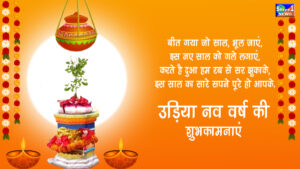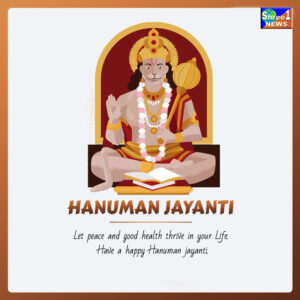Maha Vishuba Sankranti is observed as the Odia New Year and is also known as Mesha Sankranti and Pana Sankranti in the eastern state of Odisha in India It is also known as Mesha Sankranti and Pana Sankranti. On Sunday, April 14, 2024, is Maha Vishuba Sankranti in accordance with the Odisha government calendar. the Mesa Sankranti, or Baisakha (April–May) month.In addition, the day is celebrated as Hanuman Jayanthi, which commemorates Hanuman’s birthday (only in Odisha). In the Oriya Solar Calendar, this day is the start of the traditional New Year. This is also when the summer season begins.It is important to note that this is the first day of the Oriya calendar.The freshly constructed almanac is read in front of the sister deities on this day, and special rites are performed at the Jagannath Temple in Puri.

Importance of Maha Vishuba Sankranti
The New Year in Odisha is calculated based on solar system of calendar calculation. Sun transits to Mesha Rashi or Aires on this day. Vishuba means Equator and Sun is over the Equator on the day.
The day is also known as Meru Sankranti, Mesha Sankranti, and Maha Vishuba Sankranti since it ushers in the Mesha solar month. On this day, which heralds the arrival of summer, we celebrate by drinking our own energy drink, pana, and drinking chhatua, a cereal mix that helps us stay cool.
Pana Sankranti
The highlight of the day is the preparation of sweet drink called ‘Pana,’ which is made from fruits, milk, curd etc.
The story of Jala Sankranti is associated with Bhishma of the Mahabharata and is mentioned in the Bhavishya Purana.
‘Bhishma after being defeated by Arjuna in the Mahabharata war was lying on a bed of arrows (Shara Sajya). Pandavas and Kauravas had assembled near him and he asked for some water. Arjun then aimed an arrow in the ground and from the crevice created by the arrow appeared Holy River Ganga to thirst the quench of Bhishma.
Out of contentment and compassion Bhishma said that those people who would offer cold water to thirsty people on this day would not only be free from all sins, but also the departed souls of their ancestors as well as the Gods in heaven would be pleased.
In remembrance of this day people in Orissa distribute water and a popular drink called Pana.
According to the Hindu calendar, the holiday spirit begins one month early, during the month of Chaitra. To make the fortunate day heavenly in accordance with their beliefs, people in villages plan folk dances and spend the entire night doing so.
They utilize a small pot that is filled with “pana,” or a sweet beverage made with Mishri and water that is hung from a tulsi (basil) plant. This pot has a hole in the bottom through which rainwater can fall, symbolizing the rain.
People take baths (Sankranti buda) in rivers, ponds, lakes, or the ocean when they get up early. Then, while standing in knee-deep water, they adore Lord Surya. One chants the Gayatri Mantra.
Some people perform donations and yajnas.
Many make it a point to visit a temple in the vicinity.
Some people keep a fast on the day.
The special drink Pana is served on the day. It is made of pulp of Bilva (wood apple or bela), coconut gratings, and cottage cheese. The drink is seasoned with ginger and black pepper.
The flour of horse gram chhatua, along with banana and curd, is consumed by the people of Odisha after offering it to the Tulsi plant.

Special Tulsi Puja and Rituals
On this day, care is taken to provide shelter to the ‘tulsi’ plant. A ‘chhamudia’ (shed) is built above the ‘tulsi chaura’ using ‘jamu’, neem and mango branches. A little ‘ghadi’ (earthen pot) is placed below the shed which has a little hole on its bottom. A ‘kusha’ is placed within that hole to ensure smooth flowing of water that is placed inside the pot. This is how, people ensure that the basil plant gets sufficient water and is safe from the scorching heat.”

Hanuman Jayanti
According to Odia tradition, Pana Sankranti is the birthday of the Hindu deity Hanuman, who is famous for his devoted devotion to Vishnu’s incarnation Rama in the Ramayana. On the new year, his temples are revered along with those of Shiva and the sun deity Surya. The temples remain crowded and people chant Hanuman Chalisha throughout the day. Reading the Sundarkaand on this day is also said to be a pious exercise.
On Pana Sankranti, Hindus also travel to temples dedicated to the goddess. Among the temples are the Sarala Temple, Cuttack Chandi, Biraja Temple, Samaleswari Temple, and Taratarini Temple, which is located close to Brahmapur in Odisha. In Sarala Temple, during the Jhaamu Yatra fire-walking festival, monks ambulate upon scorching coals. The Patua Yatra event takes place in the Maa Patana Mangala Temple in Chhatrapada, Bhadrak, from April 14 to April 21. This event is called Chadak Parva in North Odisha. In Southern Odisha, the Meru Yatra festival is celebrated as the end of the month-long Danda nata dance festival. Thousands of devotees gather at the Shakti Pitha shrine in the Taratarini Temple because it is one of the auspicious days during the Chaitra Yatra. People from all over the state eat festive chhatua and drink Bel Pana to mark the occasion.







 Finance
Finance







